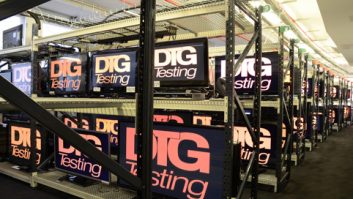By Peter White, CEO, IABM
As the only association that represents the broadcast and media technology supply industry worldwide, we provide a unique perspective and understanding of the critical issues facing those businesses. We have a presence at every major trade show and each event offers a different platform for us to gauge opinions and encourage discussion around the challenges most affecting our members and industry colleagues.
The general mood is that there is still a fair degree of uncertainty in the market. The latest round of quarterly IABM figures show continuing improvement but not dynamic growth and certainly some of the smaller businesses are having a tough time at present. Overall market growth for the next few years forecasted in our Global Market Valuation and Strategy Report (GMVR) is modest with a marked swing away from hardware products to software and services.
Our half yearly market surveys, both on the demand and the supply side, say the future is stable – however, people are expected to remain cautious with their spending.
The point of view of many in the industry seems to be that a lot of customers in the broadcast and media space are sitting on their hands. The path to take them forward is not clear cut, and to some extent there is a degree of waiting and observing the industry before committing to any further investments.
That is perhaps inevitable, given the disruptions happening in the industry today. Most obviously there is the transition from traditional broadcast hardware towards a full IP solution. Software-defined infrastructures are a significant departure, which lead us to the question is the technology ready yet?
4K? Will this happen, or is this another side issue? What about the other elements of Ultra HD, like high dynamic range or high frame rate?
We have faced the issues around multi-platform delivery, but will there be further challenges in terms of distribution? There are questions surrounding how new architectures dovetail with them.
There is a sense of irony as the first problem is actually the solution. A well-designed IP-centric system could – and should – be independent of the nature of the content. So if, say, 4K suddenly becomes a transmission standard, then that should simply be a case of updating a couple of numbers in a parameter file.
This very much depends on all the elements of a modern broadcast system working in cohesion. Which in turn means that systems from multiple vendors will play nicely together. It is not in anybody’s interests to commit to a future of proprietary systems: we all know that best of breed solutions means we get the required functionality.
What is needed in the future is a champion for this level of interoperability. In particular, the smaller players should be heard, their focus on innovation brings the key niche products that could give broadcasters and media companies the critical business or creative edge.
At IABM, we can provide at least the opportunity to talk, to address the technical and commercial issues around interoperability, and maybe a platform to define and test new solutions. It is clear that “co-opetition” – rivalry with a common goal – is now more important than ever.
Many of the current challenges facing the industry will be discussed at this year’s show and, as ever, the IABM team will play a very active role. At IBC, we have our much anticipated State of the Industry conference, which should help to provide some context of many of these topical issues. We also have a number of additional events planned, from our new HEVC workshop, the ever-popular member lounges and our first event focussed on M&A. In between we will dedicate as much time as possible talking to our members and the wealth of companies exhibiting here at IBC.
Vendors need to understand the issues facing their customers, in terms of changing business models, and in planning a gradual and graceful change from today’s infrastructures to the software-defined world. If they can see that investing in one piece of the jigsaw at a time is going to boost their capabilities today without limiting their opportunities tomorrow, then we may break the log jam, and business – for all of us – will start moving again.







